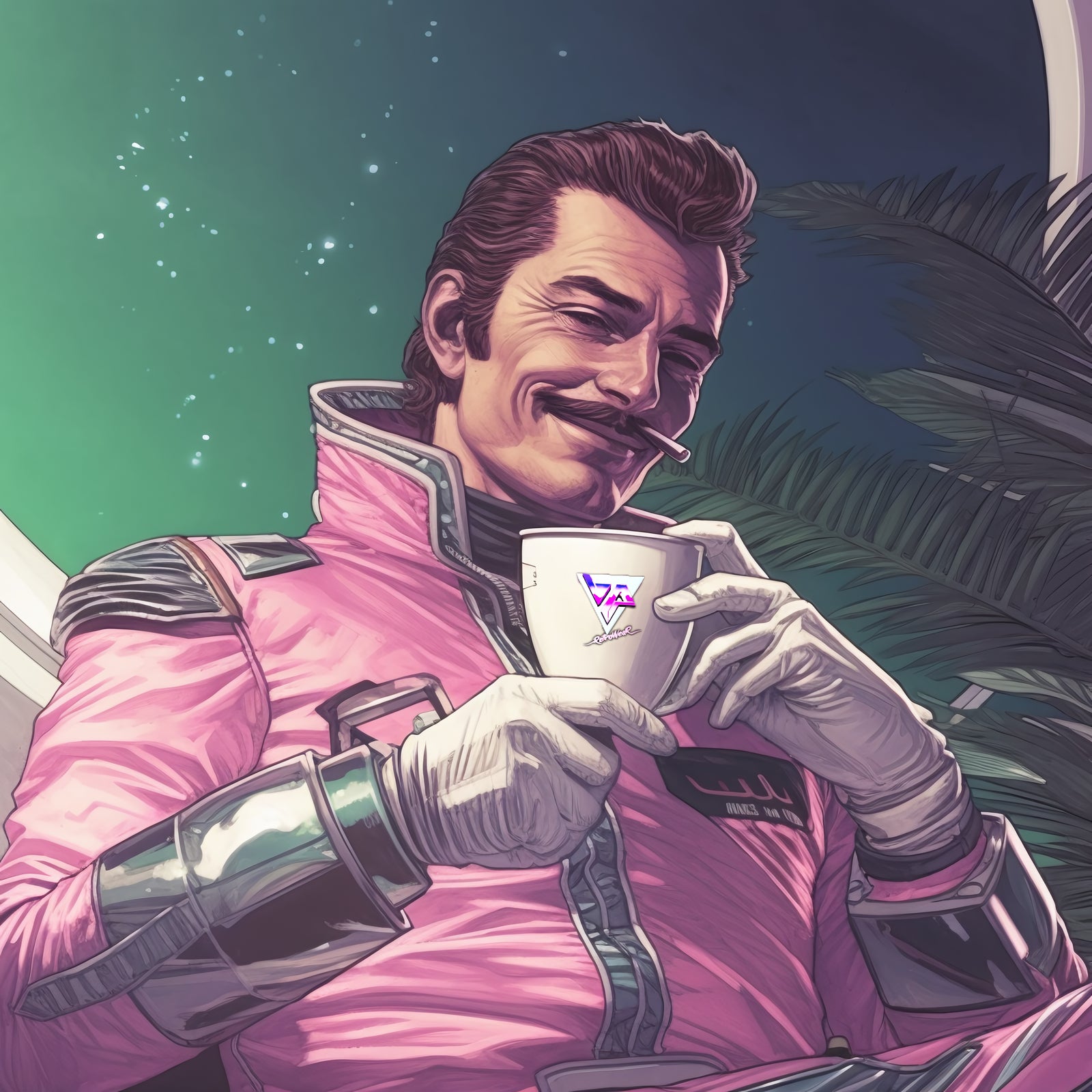Your Cart is Empty

The 25 Best Cult Movies of The 1980s
November 13, 2018 19 min read
Perhaps more than any decade before or since, due largely to the home video market, the 1980s was a great time for cult films. Part of the attraction with these movies designated with cult status is that they are decidedly different and much more provocative than mainstream populist fare.
25. The Goonies (1985)

With a funny and fast-paced script by Chris Columbus, from a story by Steven Spielberg (who executive produced), this idiosyncratic and very Scooby Doo-like actioner set in Astoria, Oregon, pits a group of young misfit kids (including Sean Astin, Josh Brolin, Corey Feldman, Kerri Green, and Martha Plimpton) against a family of criminals (including Joe Pantoliano and Anne Ramsey) in a race to retrieve the long-lost treasure of fabled 17th-century pirate, One-Eyed Willy.I was ten years old when director Richard Donner unleashed his silly, pre-teen adventure epic The Goonies and I fully admit that, as a result, my mantra for a time became: “Goonies never say die!”
Armed only with a treasure map, some Baby Ruth candy bars, a few zany inventions, their wits, and a bag of marbles, will the Goonies be good enough to find the fortune, and with it save their neighborhood from demolition? And will the image of a tormented Chunk (Jeff Cohen) doing the “truffle shuffle” at Clark “Mouth” Devereaux’s (Feldman) mean-spirited request ever fade from your memory?
This is a nostalgic grab bag of funhouse spills and thrills that meant a lot to audiences as kids and may mean even more to them now as sentimental adults.
24. Pee-Wee’s Big Adventure (1985)

“You don’t wanna get mixed up with a guy like me. I’m a loner, Dottie. A rebel.”
Impressed by his strange stage show at the Groundlings theater, Warner Brothers contracted Paul Ruebens to write a feature based around his quirky, child-like überbrat persona, Pee-Wee Herman. Inspired, strange as it sounds, by Italian neo-realist innovator Vittorio De Sica (specifically his celebrated 1948 film, The Bicycle Thief), Reubens wrote one honey of a nonconformist comedy and found the ideal director, a former Disney animator looking to leap into live-action features, Tim Burton.
Together Burton and Reubens combined Dalí-like surrealism into a live-action cartoon that would anticipate the long-running subversive Saturday morning kids show, Pee-Wee’s Playhouse (1986-1990), sequels, Big Top Pee-Wee (1988), Pee-Wee’s Big Holiday (2016), and introduce Tim Burton to the world at large.
With great gags, stunningly silly production design, and overflowing quotable quips, it’s no wonder discriminating audiences ate it up.
23. Lady Terminator (1986)

One of the most celebrated of Indonesian trash cinema from the 1980s, Lady Terminator intentionally bears many similarities to James Cameron’s 1984 hit The Terminator. Ostensibly the well-told tale of an indestructible cyborg stirring up trouble amidst an urban landscape, director H. Tut Djalil’s does add a few wrinkles of it’s own as well as lifting heavily from the Indonesian myth of the South Sea Queen –– a sexually insatiable and emasculating succubus-like legend.
The spirit of the South Sea Queen curses her enemy’s granddaughter, a naive American researcher named Tania Wilson (Barbara Anne Constable), she’s soon decked out in Arnold Schwarzenegger-looking black leather and accoutrements, to fulfill a 100-year-old curse that amounts to the usual; annihilation and doom. Soon castrated male corpses pile up and a ceremonial dagger is sought after, it being the only way to end Tania’s possession, apparently.
The campy, kitschy, OTT excessiveness of it all makes Lady Terminator a lively, sexually charged, and silly pisstake on gender politics, Western beliefs, and irresponsible Western ideology. Oh, and did I mention that Lady Terminator has lethal eye lasers?
22. Basket Case (1982)

In writer-director Frank Henenlotter’s Basket Case, Duane Bradley (Kevin Van Hentenryck) is a normal, even pleasant looking fella who carries around a wicker basket and oh, his monstrously deformed gristly little jealous twin is in there, and he scuttles around killing people. This is an amazing movie.
The schlock and sleaze on brutal display as Duane checks into a sleazy New York City hotel and allows his deformed twin Belial –– with whom he has a psychic link –– to go on a jealousy-fuelled killing spree, is a lot of gross out fun, frankly. And Henenlotter would ride the cult success of the film into two sequels oddly enjoyable sequels; Basket Case 2 (1990) and Basket Case 3: The Progeny (1991).
Basket Case is the film that Rex Reed referred to as being “…the sickest movie ever made!”, and Henenlotter wisely took this as a compliment. To miss this would be to miss out on a shit ton of disgusting fun.
21. Streets of Fire (1984)

Opening titles inform us that Walter Hill’s rock ‘n roll fable unfolds in “another time, another place” and the resulting neo-noir musical romance to follow, full to brim with action and juicy one-liners is full-tilt awesome if you can buy the premise.
Ellen Aim (Diane Lane) is an adored rock star who’s been kidnapped by one Raven Shaddock (Willem Dafoe), leader of a badass biker gang known as The Bombers. Lucky for Ellen, her ex-lover Tom Cody (Michael Paré) is a soldier-for-hire who teams up with a feisty mechanic and former soldier named McCoy (Amy Madigan) to infiltrate The Bombers stronghold, a cesspit called “the Battery”, that will result in an all-out, guns-blazin’, motors-revin’, battle through a 1950s-retro cityscape.
More akin to Hill’s comic book colorful, overtly stylish, and extravagantly violent fare like The Warriors (1979), this singular and strange pastiche of 1950s biker films and then contemporary 1980s music videos is a fun, fast-paced, and fist-pumping ride that’s worth it not only for the dreamy Lane, but for Madigan’s tenacious tough girl (she also gets all the best lines), Dafoe’s scenery-chewing, and early roles from Bill Paxton and Ed Begley, Jr., amongst others.
20. Near Dark (1987)

Director and co-screenwriter Kathryn Bigelow bravely reimagines the vampire mythos with a trailer-park Americana sensibility in her astonishing sophomore film, Near Dark. A genre mashup of two formulaic film types––the Western and the vampire movie––Near Dark also offers a romantic and contradictory fable for the midnight movie crowd.
Lance Henriksen is the patriarchal figure to a rogue band of vampires that also includes a spurs-adorned Bill Paxton and Joshua John Miller’s man-trapped-in-a-child’s-body blood sucker. Toss in a first rate soundtrack by Tangerine Dream and the resulting film is a heady mix of extravagance, poetics, violence, and unrequited love. For all it’s flaws and imperfections, Near Dark still maintains a near perfect serrated edge of dark artistry.
19. Tetsuo: The Iron Man (1989)

The boundary pushing body horror on shrill display in this cyberpunk fright flick is a large part of what made this low budget effort from cult-film director Shinya Tsukamoto a hit with the midnight movie crowd.
Shin’ya Tsukamoto is the metal fetishist gone mad –– perhaps due to the writhing maggots that pour from his wounds where metal melds to his disgusting skin –– who is mowed down on the highway by Salaryman (Tomorrow Taguchi) and his girlfriend (Kei Fujiwara). These reckless lovers then dispose of his body by dumping it into a ravine. Little did they suspect this would provoke a decidedly nasty curse that transforms the flesh into iron in as many painful and vomitous ways as possible. Ain’t karma a bitch?
This strange, sometimes boring, sometimes fascinating, frequently gory, often funny, and always fucked up film would go on to father two just as transgressive sequels; Body Hammer (1992) and The Bullet Man (2009) while cinching Tsukamoto as an international provocateur of unconventional cult cinema.
It’s also fair to say that this is a film for extreme fans but, that said, admirers of David Cronenberg (particularly 1983’s Videodrome) and David Lynch (shades of 1977’s Eraserhead are ample) might dig some of the surreal strangeness as well.
18. Big Trouble in Little China (1986)

Enthusiastically described by Guillermo del Toro as “sheer pulp brilliant and dazzling magic,” and “the first of a franchise that should have been”, the trials and tribulations of the hard-boiled and fast talking trucker Jack Burton (Kurt Russell) are nearly impossible to resist. Caught in a sinister and strange conflict that he barely understands that’s unfolding within, underneath, and all around San Francisco’s Chinatown, Jack just can’t seem to dodge the unfolding dangers.
The silly and yet still very engrossing saga that Jack is snagged in involves a dangerous street gang called the Lords of Death, an evil sorcerer named Lo Pan (James Hong), a gorgeous green-eyed woman named Miao Yin (Suzee Pai)––fiancée to Jack’s BFF Wang Chi (Dennis Dun)––his own buddying beauteous love interest Gracie Law (Kim Cattrall), and a trio of powerful warriors under the nomenclature “The Three Storms”; Thunder (Carter Wong), Rain (Peter Kwong), and Lightning (James Pax). There’s ancient curses, martial arts action aplenty, fearsome orangutan-like monsters, and more.
A wonderful live action cartoon that sadly failed to connect with audiences at the time, thankfully home video editions of Big Trouble have performed well, as have deluxe Blu-ray editions, late night showings at repertory cinemas, tie-in video games, comic books, card and board games as well as constant rumors of a remake, have all added to the film’s mystique. One thing’s for certain, Jack Burton and the Porkchop Express are pop culture touchstones and their cinematic reconnaissance is easy to enjoy. A gem.
17. The Adventures of Buckaroo Banzai (1984)

Director W. D. Richter lavishes much love upon the action-y and sci-fi conventions comprising The Adventures of Buckaroo Banzai Across the 8th Dimension. A perfectly cast Peter Weller as the eponymous hero, Dr. Banzai isn’t only a scientist, a samurai, and a test pilot-driver, he also fronts an awesome 80s rock and roll band, The Hong Kong Cavaliers.
The plot focusses on Dr. Banzai’s efforts to assess the 8th dimension overlap of his dimension spanning prototype automobile which will soon suck into its orbit a mad scientist named Emilion Lizardo (John Lithgow), potential femme fatale Penny Priddy (Ellen Barkin)––a deadringer for Banzai’s departed wife––and, amongst other show-stopping incidents and excitations, Jeff Goldblum’s cowboy lovin’ neurosurgeon sidekick New Jersey, and Christopher Lloyd’s scenery-chewin’ turn as––say it right, now––“Bigbooté!”
16. Hairspray (1988)

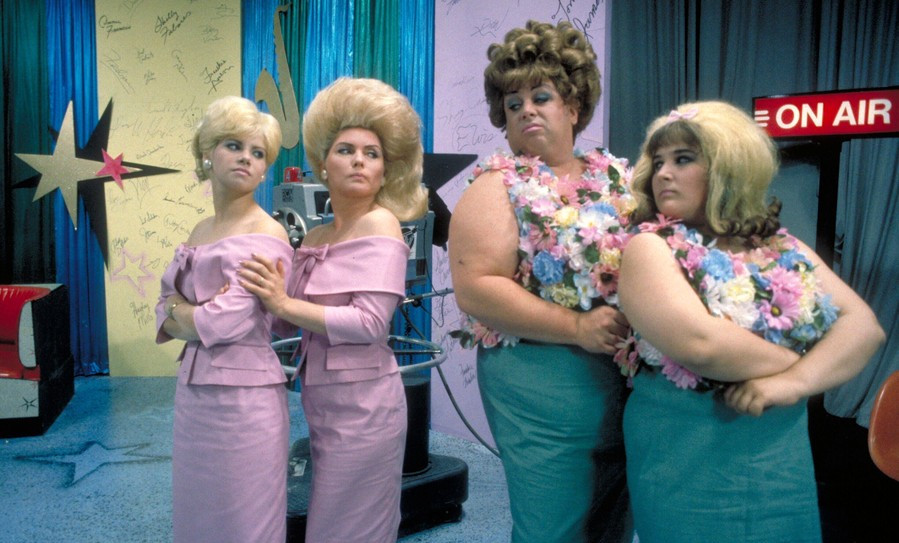 Baltimore, Maryland’s favorite sicko son, John Waters, unleashed perhaps his most well known and well received mainstream success with this romantic comedy musical Hairspray –– a modest hit at the box-office that got huge once it hit home video markets in the years that followed (and much later it would be adapted into a Tony-winning Broadway play and get a second film version in 2007).
Baltimore, Maryland’s favorite sicko son, John Waters, unleashed perhaps his most well known and well received mainstream success with this romantic comedy musical Hairspray –– a modest hit at the box-office that got huge once it hit home video markets in the years that followed (and much later it would be adapted into a Tony-winning Broadway play and get a second film version in 2007).
Ricki Lake is a treat as Tracy Turnblad, a “pleasantly plump” teen in an uptight and unfortunately segregated 1962 Baltimore. After auditioning for a spot on The Corny Collins Show –– a popular TV teen dance show –– she somehow manages to beat out her spiteful rival Amber von Tussle (Colleen Fitzpatrick) while simultaneously entrancing her boyfriend, Link (Michael St. Gerard).
Soon Tracy befriends some black students at her school and pushes for more equality and integration on Corny’s (Shawn Thompson) show. This causes a lot of controversy all over town, particularly with Amber’s asshole parents played hilariously by pop music icons Sonny Bono and Deborah Harry.
Eschewing the X-ratings of his earlier and infamous works (such as 1972’s Pink Flamingos and 1974’s Female Trouble), for a surprisingly sweet PG, Hairspray is still a pretty confrontational piss take on social mores and artful subversion. It’s also full of humor and retro hijinks.
15. Akira (1988)

The most influential anime of all time, Katsuhiro Ôtomo’s Akira is an ambitious and often breathtaking cyberpunk-addled post-apocalyptic pageant.
Convoluted to a fault, Akira is set in Neo-Tokyo some years after a nuclear accident decimated the city, and it has been rebuilt, and yet still stands on the precipice of disaster thanks to government meddling with strange psychic superpowered kids. There’s also a wealth of youth biker gangs, oversexed kids and Juggalos mostly, out for kicks and dollops of ultra-violence plaguing the city.
Akira is best enjoyed if the frequently nonsensical narrative leaps of the bloated third act are largely ignored, and emphasis is put on the vastly detailed images and first-rate animation––some of the best hand drawn imagery ever wed to celluloid.
Blade Runner and cyberpunk fans will enjoy the many visual cues and the cityscapes and bike chases are absolutely breathtaking. Add a pulsating soundtrack from Tsutomu Ōhashi and you’ve got one of the most phenomenal films of its kind.
14. They Live (1988)

Like a frenzied crash course in semiotics and media manipulation, John Carpenter’s They Live is a politically subversive B-movie combining horror and sci-fi with hair-raising results. Adapting Ray Nelson’s short story “Eight O’Clock in the Morning”, about mass alien hypnosis duping humanity via TV commercials, radio, and print media, Carpenter also steeps the proceedings in satire and casts WWF wrestler “Rowdy” Roddy Piper as John Nada, our two-fisted hero.
Nada is sympathetic and relatable as a blue-collar drifter trying to get by when he stumbles upon a pair of sunglasses that breaks the alien signal allowing their hidden messages to be visible––dollars bills suddenly read “THIS IS YOUR GOD”––along with their hidden-in-plain-sight swarms, secretly integrated amongst us. “You know, you look like your head fell in the cheese dip back in 1957,” quips Nada to an alien, giving up his element of surprise before he even knows the stakes.
They Live requires a little forgiveness from the audience as its plot holes are many, and leaps in logic are necessary to ignore, too, but the film’s a shit ton of fun if you surrender to it, and Piper’s back-alley brawl with Keith David is a highlight, and certainly one of the longest and most mirthful fisticuffs in movie history, too.
13. Superstar: The Karen Carpenter Story (1987)
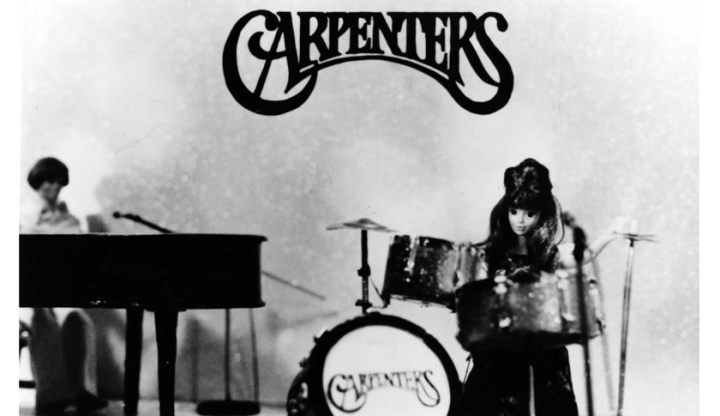

Before establishing himself as one of American cinema’s most talented auteurs, Todd Haynes first grabbed people’s attention with this controversial biographical short film, Superstar: The Karen Carpenter Story. Following the final seventeen years in the life of Karen Carpenter –– part of the famed 1970s musical duo the Carpenters –– from her musical breakthrough in 1966 to her tragic death in 1983 by cardiac arrest (a result of her sad struggle with anorexia), the controversy of Haynes’ film is two fold.
On the one hand he told this story not just without the Carpenter family’s cooperation, but in direct conflict with them (which included using many of the Carpenter’s songs without permission), and in place of actors the film is shot using Barbie dolls (against the wishes and without consent from Mattel, Inc., the owners of the fashion doll).
And yet for all the gimmickry and exploitation on display, Superstar: The Karen Carpenter Story packs considerable dramatic punch. The fact that the film, after doing a successful festival run back in the 80s, isn’t by law allowed to be screened theatrically –– owing to lawsuits from Richard Carpenter that resulted in “all copies of the film being recalled and destroyed”.
Though copies do exist, such as one owned by the Museum of Modern Art in New York (though they are not allowed to screen it publicly), not to mention bootlegs and the Internet, which all keep the cult of Superstar alive.
12. The Killer (1989)

This is the film that single-handedly established Hong Kong action cinema as a distinct and dangerous brand –– even though director John Woo, and star Chow Yun-Fat had done previous work together. So much of the dizzying action in The Killer has been lifted and inserted in every action film you’ve seen since, such as Chow’s iconic gun-in-each-hand slide and Woo’s signature slo-mo fluttering doves. Does that make it any less awesome here? No. No it doesn’t.
The Killer is full-tilt action to be sure, it’s also overt melodrama as sentimental hitman Jeffrey Chow (Chow) is only in the assassination game these days so that he can afford an operation that will hopefully restore the eyesight of Jennie (Sally Yehi), a nightclub singer who was blinded in a firefight that Jeffrey instigated.
The film that follows is an orgiastic affair of fetishized violence, comic book gunplay, crazy stunts –– the action scenes were improvised on the set with the actors, stuntmen, and stunt coordinator –– soap operatics straight from Douglas Sirk, black comedy, and sparkling wit. Like all the films on this list, this one’s not for everybody but it might be right for you. Recommended.
11. Hellraiser (1987)

Clive Barker brought terror, psychosexual symbolism, S&M, and a new horror icon dubbed Pinhead (Doug Bradley), gnashing and snarling into the world with this transgressive, subversive, and shocking directorial debut. Based off his own novella, Hellraiser is a cruel celebration of deviant horror, primal trauma, and fucked up Freudian imagery.
Barker’s Cenobites (extradimensional beings summoned via sex magick, with a predilection for pleasure through pain) led by the aforementioned Pinhead combine with surreal imagery that jump started a series of spinoffs and sequels that are still subjugating fans far and wide and back in 1987 Stephen King famously dubbed him “the future face of horror.”
Hellraiser also succeeds as a startling satire of Marquis de Sade’s explicit proclivity and fetish as well as being a great example of 1980s horror done right. As Pinhead proudly proclaims: “We have so much to show you.”
10. The Blues Brothers (1980)

Setting out on “a mission from God” to raise $5,000 to save their childhood parrish, Jake (John Belushi) and Elwood (Dan Aykroyd) Blues strive to put their old band back together and launch a successful tour while they’re at it.
Director John Landis joyfully transitions the Blues Brothers –– a blues soul revivalist band born in 1978 as a musical sketch on Saturday Night Live from Aykroyd and Belushi –– to the big screen, allowing them to rack and ruin across the midwest with all the charm and silliness fans had come to expect from the duo.
While essentially a one-joke gimmick flick, it works in large part due to the charisma of the leads, the conquering combo of slapstick destruction they manufacture (the numerous car chases in the film are hysterically astounding), and the music they deliver––buttressed greatly by an amazing string of cameo musical legends, including James Brown, Ray Charles, and Aretha Franklin.
Other unanticipated, and perhaps unnecessary cameos also add a lot of color and distraction from the likes of John Candy, Carrie Fisher, Paul Reubens, Steven Spielberg, and Twiggy, too.
In the years since its release The Blues Brothers has acquired considerable cult status –– late night screenings across the globe have turned into an engaging audience-participation show –– and not to mention that the trademark black suits, hats, and Ray-Bans have made for easy to assemble last-minute Halloween costumes for a few decades now.
9. Repo Man (1984)

Alien corpses, secret governmental conspiracy, psychopathic suburban punks, one-legged dames, a glowing Chevy Nova that flies and some reluctantly heroic debt collectors populate Alex Cox’s daring debut feature, Repo Man.
Absurdity, outsider art, and midnight movie mirth collide in this absurdist sci-fi farce that stars the ever awesome Harry Dean Stanton as Bud, who’s paired with the against-type casting of Emilio Estevez as Otto Maddox on an oddball adventure that sends up alien invasions, the LA experience, rampant consumerism, punk rock ethos, and all with an unerring energy and sense of sarcastic play.
Another pleasure of the film, of which there are so many, is cinematographer Robby Müller’s fresh perspective and cloudless camerawork. A postmodern pageant, Repo Man is a cult classic you should certainly go searching for if you haven’t already.
8. The Toxic Avenger (1984)

Crass, campy, and gruesomely violent, who could have guessed that this satirical superhero horror comedy film, The Toxic Avenger, would generate three silly sequels, a successful stage musical, and even a TV cartoon aimed at the kiddies –– complete with collectable action figures?
Certainly when directors Michael Herz and Lloyd Kaufman (who also co-wrote the film along with Joe Ritter), along with Troma Entertainment, set out to delightfully disturb niche audiences of their usual B-movie mindlessness, who could have predicted their puerile pisstake would generate such odd adoration? Hell, Toxie and company put Troma on the map!
Mark Togl is Melvin Ferd, a 98-pound nerd janitor from New Jersey who fatefully finds himself in a vat of toxic waste that will transform into the eponymous Toxic Avenger (Mitchell Cohen) as all sorts of hilarity, obscenity, and carnage will ensue.
The town of Tromaville will never be the same again, and don’t let the milder sequels and the kid-friendly cartoon fool you, this film that started it all is not for the little ones or the easily perturbed. There’s heaps of cruelty, buckets of blood (and other fluids), every kind of nasty exploitation, and non stop vulgarity. In short, the Toxic Avenger is an all-out riot.
7. Brazil (1985)
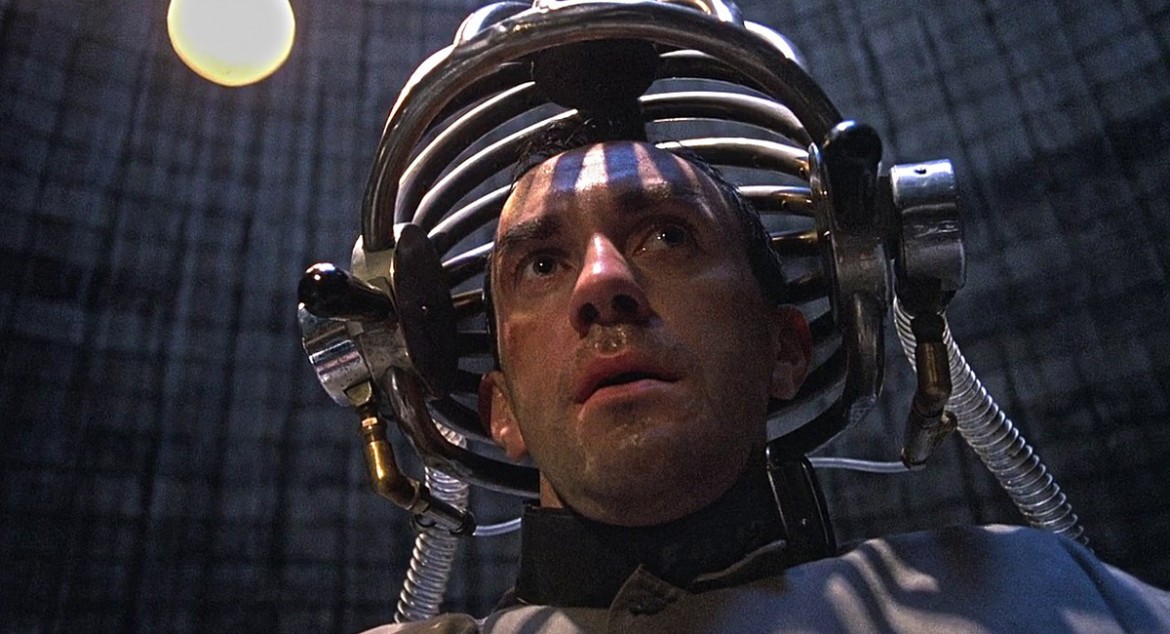

Terry Gilliam perfected the movie mindfuck with his dystopian satire Brazil. This dense, detailed, and visually rich sci-fi fantasy pairs sublimely with a strangely nostalgic retro-future where unexceptional everyman Sam Lowry (Jonathan Pryce) is but a cog in an Orwellian governmental machine.
There’s a slapstick quality to Brazil, which was written by Gilliam along with Tom Stoppard and Charles McKeown, and a majestic ambition in its futuristic depiction of bureaucracy gone mad, and for all it’s bizarro visuals –– terrorists with baby-faced masks, angelic dream sequences, Lowry’s mother’s endlessly odd facelifts to retain her youth –– it’s a film that can be deliberately hard to follow. That doesn’t mean that Brazil isn’t Gilliam’s finest hour, for it certainly is.
The original title for Brazil, according to Gilliam, was 1984½. “Fellini was one of my great gods,” says the director, “and it was 1984, so let’s put them together.” This easily accounts for the arthouse instincts of the film, as well as the surreal and very serrated edge in this playfully pretentious but still remarkably miraculous sortie into the imagination.
6. Videodrome (1983)

Videodrome is vintage Cronenberg and easily his most influential and conceptually ingenious film. Chronicling psychological and societal collapse with an Hieronymus Bosch-like eye for morbid detail and deranged intelligence, this is a film that’s impossible to forget.
Described by Andy Warhol as “A Clockwork Orange of the ‘80s”, this sci-fi-horror hybrid from Canadian iconoclast David Cronenberg presents a prophetic vision of a dystopian future where television, media piracy, pay-per-view violence, rampant perversion and torture porn rule the ratings.
Max Renn (James Woods) is the owner of a trashy TV station who’s forever searching for risqué programming to broadcast. Soon Max discovers the torture/snuff show known as “Videodrome” and he must acquire it for his network. Along the way Max meets radio personality/sadomasochistic psychiatrist and femme fatale Nicki Brand (Deborah Harry) and events intensify as an erotic dream logic kicks in.
Part aphrodisiac and part body horror nightmare, Videodrome is a sensual and scary tour de force and makes for absolutely indispensable viewing.
5. Re-Animator (1985)

Stuart Gordon’s fast-paced, funny, and wonderfully bombastic adaptation of H.P. Lovecraft is a quintessential 1980s B-movie with lasting charm, trash appeal, loads of explicit sexual perversion and serrated social criticism. Sound like a mouthful? It is!
Gothic sensibilities pair with splatter comedy and genius practical effects as Gordon and producer Brian Yuzna (also a legend in cult horror from that era) hilariously and horribly revise the mad scientist trope and make an iconic antihero in Herbert West (Jeffrey Combs) and his arch rival Doctor Hill (David Gale).
Easily Gordon’s most enjoyable film, and the first in the Re-Animator franchise, it’s an irresistible little shocker that’s as disturbing as it is comical and is, make no mistake, a genuine genre original. Not to be missed.
4. Dirty Dancing (1987)

“Nobody puts Baby in a corner,” speaketh Johnny Castle (Patrick Swayze) in this silly, sensational, and cultural touchstone romantic dance film from Emile Ardolino, Dirty Dancing.
Jennifer Grey is Frances “Baby” Houseman who has one last summer before the Peace Corps whisks her away and aww heck, wouldn’t you know it? Baby is stuck in a sleepy, dull resort in the Catskills with her folks. Enter Johnny, the resort’s exceptionally studly dance instructor –– whom Baby’s father forbids she see –– and before you know it they’re both getting naughty on the dance floor in preparation for the last big shimmy of the summer, or something like that.
The predictable plot and placeholder characters are all forgivable due to the charisma and hot bodies of Grey and Swayze, both relative unknowns at the time, and while it made a profit at the box office it was home video that really pushed Dirty Dancing into the stratosphere of cultdom.
A lame prequel would follow, Dirty Dancing: Havana Nights (2004) and an even lamer remake in 2017, but the original is where it’s at, even after all these years. The image of Grey and Swayze, sweaty and grinding against one another to Bill Medley and Jennifer Warnes’ “(I’ve Had) The Time of My Life” became airily iconic and emblematic of 1980s American cinema and popular culture as a result.
“…and I owe it all to yooo-eww-eeww!!”
3. Evil Dead II (1987)

Sam Raimi hit his stride with this gleefully gory splatter comedy, the second of the still ongoing Evil Dead series that made star Bruce Campbell something of a horror movie superstar, an indisputable cult hero, and immortalized his flippant and nonchalant delivery of the one word line: “Groovy!”
Ostensibly a remake of the earlier 1981 film The Evil Dead, only here there’s more of an emphasis on laughs and Three Stooges-inspired physicality, with the horror elements more played for outlandish and gross thrills then for the darker nightmare fuel of the original.
It’s still dark –– who are we kidding here? –– but there’s no tree molestation, for instance, like the more severe original. And this recalibration of what makes the movie work best was a wise move from Raimi, who also co-wrote the script with pal Scott Spiegel.
Ash Williams (Campbell) and his girlfriend Linda (Denise Bixler) just can’t seem to have a romantic getaway at a secluded cabin in the woods for the life of them, and that the cabin in question contains the Book of the Dead –– a deadly, demon summoning relic of antiquity that people have a terrible habit of reading aloud from –– as well as some pre-recorded tapes of evil spirit conjuring text, well next thing you know there’s geysers of blood, chainsaws, projectile eyeballs, witch carving, and all sorts of other nastiness on gauche display.
Evil Dead II is probably the best film in the franchise which was followed in 1992 by Army of Darkness, a fourth sequel and kinda sorta remake in 2013 by Fede Álvarez, as well as the splatter-ific fan service spectacular Ash vs Evil Dead (a gruesome and groovy TV series for the Starz network, about to enter its third season), and don’t forget all the Evil Dead action figures, video games, comic books, and there’s even an off-Broadway rock musical.
To paraphrase Ash as he fired up the ol’ chainsaw and moved in on some evil demons; “who’s laughing now… who’s laughing NOW?!”
2. Withnail & I (1987)
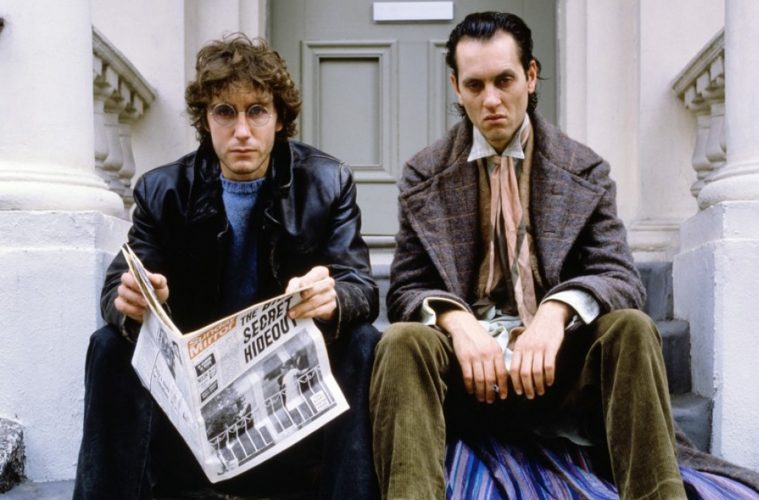

The archetypal British cult film comedy, writer-director Bruce Robinson’s semi-autobiographical eulogy to unemployment and acquaintanceship, Withnail & I, is a tiny tour de force.
A mélange of quotable discourse (“We want the finest wines available to humanity, and we want them here, and we want them now!”), not to be forgotten characters (Richard E Grant’s Withnail is absolutely iconic, and Richard Griffiths’ Uncle Monty is divine and pitiably droll), coarse social commentary, and elegant farce, guarantee greatness.
Set in a dog-eared Camden-Town flat at the ass-end of the 1960s, Withnail & I fixates on two actors on the dole, and their attempts to return to form. Narrated by Marwood, played by Paul McGann, life is anything but biscuits and butter drips. Withnail, a lovable but self-destructive drunk, doesn’t so much buoy his friend, as hold him down. Taking an ill-starred holiday in the country ultimately alienates the pair, but not after many booze-soaked scenarios play out as self-discovery and desolation ooze in.
Numerous drinking games accompany the film, a witness to its prestige. Anyone who’s ever struggled, said goodbye to a friend, or gone on a regrettable drinking binge, can find familiarity with this wonderful, witty, and humanly relevant picture.
1. This is Spinal Tap (1984)

Topping our list is Rob Reiner’s 1984 cult classic This is Spinal Tap… and why not?
Not only is this mockumentary on “Britain’s loudest band” a comedy classic, it’s barbed satirical sting on rock ‘n roll and the egos that dwell there is painfully precise, funny AF, and now an integral part of the pop culture canon of the 1980s and beyond.
Flailing filmmaker Marty Di Bergi (Reiner) decides to follow the nearly forgotten UK heavy metal band Spinal Tap on their comeback tour of America after a lengthy lull. Will this unholy trinity of aging rockers –– David St. Hubbins (Michael McKean), Derek Smalls (Harry Shearer) and Nigel Tufnel (Christopher Guest) –– be able to restore their former glory? Hits like “Big Bottom”, “Listen to the Flower People”, and “Stonehenge” may say otherwise, but watching the band implode (and in the case of an ill-fated drummer, explode) on stage, backstage, in the hotel, and on the tour bus, is all part of the fractured fun.
The improvisational master class lead by Tap truly astounds, as does brilliant comic turns from the likes of Bruno Kirby, Paul Shaffer, Tony Hendra, Fran Drescher, and June Chadwick amongst others (indeed part of the great fun in viewing Spinal Tap is keeping track of all the cameos). The music is as funny as it is furious, and the quotable quips and endless jags are unconquerable.
Credit: Shane Scott-Travis, Taste of Cinema | The 25 Best Cult Movies of The 1980s
Illustration: Big Trouble In Little China
Leave a comment
Comments will be approved before showing up.
Subscribe
Sign up to get the latest on sales, new releases and more …
CLAIM YOUR FREE SHIPPING!
- SIMPLY FILL YOUR RETRO CART
- REACH $120
- PROFIT!



